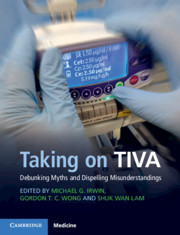Book contents
- Taking on TIVA
- Taking on TIVA
- Copyright page
- Contents
- Contributors
- Foreword
- Power to the People: the Rationale of a Practical Text
- Chapter 1 Why Bother?
- Chapter 2 You Say ‘PK’ and I Say ‘No Way!’; You Say ‘Keo’ and I Say ‘Time to Go!’
- Chapter 3 TCI and TIVA: What a Good Idea!
- Chapter 4 Milk of Amnesia
- Chapter 5 A Catwalk with a Difference
- Chapter 6 Let’s Get Started
- Chapter 7 Let’s Get Pumped!
- Chapter 8 ‘But I’m Used to MAC!’
- Chapter 9 Be Aware, Unaware and Confusion Everywhere
- Chapter 10 Do You Want Fries with That?
- Chapter 11 Intra- and Post-operative Analgesia for TIVA
- Chapter 12 Wakey Wakey!
- Chapter 13 Under Pressure
- Chapter 14 Ankle Biters
- Chapter 15 Old Timers
- Chapter 16 Big Can Be Beautiful!
- Chapter 17 A Bun in the Oven
- Chapter 18 Saving the Whales by Taking on TIVA
- Chapter 19 TIVA Drugs for Sedation
- Chapter 20 Skiing Off-Piste and Other Assorted Goodies
- Index
- References
Chapter 20 - Skiing Off-Piste and Other Assorted Goodies
Advanced TIVA
Published online by Cambridge University Press: 18 November 2019
- Taking on TIVA
- Taking on TIVA
- Copyright page
- Contents
- Contributors
- Foreword
- Power to the People: the Rationale of a Practical Text
- Chapter 1 Why Bother?
- Chapter 2 You Say ‘PK’ and I Say ‘No Way!’; You Say ‘Keo’ and I Say ‘Time to Go!’
- Chapter 3 TCI and TIVA: What a Good Idea!
- Chapter 4 Milk of Amnesia
- Chapter 5 A Catwalk with a Difference
- Chapter 6 Let’s Get Started
- Chapter 7 Let’s Get Pumped!
- Chapter 8 ‘But I’m Used to MAC!’
- Chapter 9 Be Aware, Unaware and Confusion Everywhere
- Chapter 10 Do You Want Fries with That?
- Chapter 11 Intra- and Post-operative Analgesia for TIVA
- Chapter 12 Wakey Wakey!
- Chapter 13 Under Pressure
- Chapter 14 Ankle Biters
- Chapter 15 Old Timers
- Chapter 16 Big Can Be Beautiful!
- Chapter 17 A Bun in the Oven
- Chapter 18 Saving the Whales by Taking on TIVA
- Chapter 19 TIVA Drugs for Sedation
- Chapter 20 Skiing Off-Piste and Other Assorted Goodies
- Index
- References
Summary
In keeping with the spirit of producing a practical book, we took editorial privileges and removed some of the more detailed text from various chapters and yet felt it would be a waste if some of it weren’t shared with our readers. At the same time, there are aspects of TIVA that are not necessarily recommended for novices but may entice those who have had a bit of experience and want to extend their TIVA repertoire. Therefore we thought we would create a final chapter that would incorporate some such material, hopefully in a semi-logical fashion.
- Type
- Chapter
- Information
- Taking on TIVADebunking Myths and Dispelling Misunderstandings, pp. 162 - 169Publisher: Cambridge University PressPrint publication year: 2019

